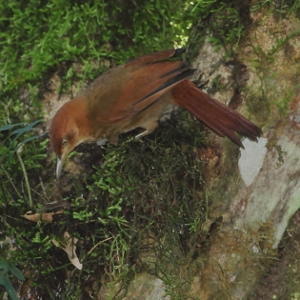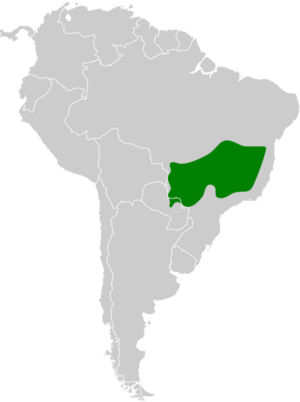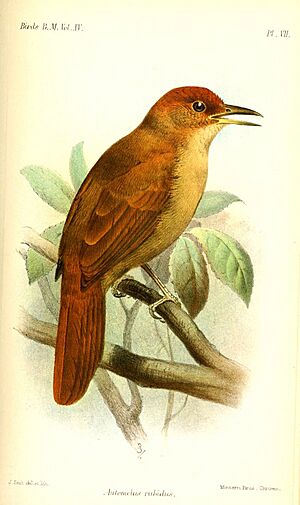Henna-capped foliage-gleaner facts for kids
Quick facts for kids Henna-capped foliage-gleaner |
|
|---|---|
 |
|
| at Jacutinga, Minas Gerais State, Brazil | |
| Conservation status | |
| Scientific classification | |
| Genus: |
Clibanornis
|
| Species: |
rectirostris
|
 |
|
| Synonyms | |
|
|
The henna-capped foliage-gleaner (Clibanornis rectirostris) is a special kind of bird that lives in the forests of Brazil and Paraguay. It's part of the ovenbird family, known for building unique nests. This bird is also sometimes called the chestnut-capped foliage-gleaner because of the color on its head.
Contents
About the Henna-capped Foliage-Gleaner
Scientists group living things into families to understand them better. The henna-capped foliage-gleaner belongs to the ovenbird family called Furnariidae. It was once placed in different groups, but now we know it belongs to the Clibanornis group.
This bird is a "monotypic" species. This means it does not have any different subspecies or types within its species.
What Does It Look Like?
The henna-capped foliage-gleaner is about 20 to 21 centimeters (8 to 8.3 inches) long. It weighs between 44 and 51 grams (1.6 to 1.8 ounces). It's a fairly large ovenbird with a long, mostly straight beak.
Both male and female birds look the same. Their face is a warm chestnut color. They have a lighter reddish area near their mouth, like a mustache. The top of their head is chestnut, which fades into a reddish-chestnut collar. Their back is a rich brown color.
Their tail feathers are chestnut, and their wings are mostly dark reddish-brown. Their throat is a pale reddish color. This color gets a bit darker on their chest and belly. Their sides are a darker reddish-brown. The feathers under their tail are reddish.
The bird's eyes are a bright yellow. Its beak is dark gray with a lighter bottom part. Its legs and feet are grayish.
Where Does It Live?
The henna-capped foliage-gleaner lives in south-central Brazil. You can find it in states like Mato Grosso, Bahia, and Paraná. It also lives in eastern Paraguay, in the San Pedro Department.
This bird likes to live in gallery forests. These are forests that grow along rivers. It also lives in deciduous woodlands. These are forests where trees lose their leaves in certain seasons. It lives in places that are between 200 and 1,000 meters (650 and 3,300 feet) high.
Behavior
Movement
The henna-capped foliage-gleaner stays in the same area all year round. It does not migrate to different places.
Feeding Habits
This bird mostly eats arthropods. These are small creatures like insects and spiders. It usually looks for food by itself or with its mate. Sometimes, it might join groups of different bird species that are also looking for food.
The henna-capped foliage-gleaner spends most of its time on the ground. It finds its prey by searching through the leaves and dirt on the forest floor.
Reproduction and Life Cycle
Scientists believe that henna-capped foliage-gleaners are monogamous. This means a male and female bird stay together to raise their young.
They build their nest from dry grass and leaves. They make this nest inside a tunnel. The tunnel is dug into an earthen bank, like a riverbank. Not much else is known about how these birds raise their families.
Vocalization
The call of the henna-capped foliage-gleaner sounds like a "dry, cackling 'kjep -kjep - -". Its song is similar to its call. But the song gets faster and turns into a rattling sound. The whole song lasts about 2 to 3 seconds.
Conservation Status
The IUCN (International Union for Conservation of Nature) keeps track of how many animals are left in the wild. In 1988, they thought the henna-capped foliage-gleaner was "Near Threatened." This meant it might be at risk in the future.
However, since 2000, its status has changed to "Least Concern." This means it is not currently at high risk of disappearing. Even though it has a fairly large area where it lives, we don't know exactly how many of these birds there are. Scientists believe their numbers might be going down.
The bird's forest home is changing. Trees are being cut down, and land is being cleared for farming. These changes might be a threat to the species. More information is needed to understand how many birds there are and if their population is truly shrinking. This bird is not seen very often and is considered rare to uncommon.



